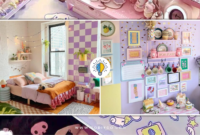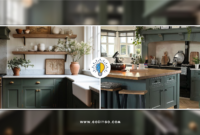Queen Victoria’s time in charge wasn’t just about politics—it was a big deal for style too! Her influence wasn’t just in the UK; it spread to Europe and even the US. People saw her as down-to-earth and cool, and they wanted to copy her taste, especially when it came to furniture.
Victorian furniture is famous for being fancy, organized, and mixing different styles together. It took inspiration from all over, like the Renaissance, Rococo, and Gothic periods. You’d often see velvet, dark woods, and lots of detailed designs like tufting and floral patterns.
Back then, making furniture changed from being handmade to being made by machines, so more people could afford it. That meant all kinds of furniture—chairs, tables, beds, you name it—got the Victorian treatment.

Bedroom from @ ourvictorianstory
And guess what? Victorian furniture is still super popular today! You might not realize it, but it’s had a big impact on furniture even in the 20th and 21st centuries. Just think about those classic Chesterfield sofas—they’re everywhere!
Brief history
Victorian furniture came in all sorts of styles because it spanned a big chunk of time. You had stuff that looked like it came from medieval castles with pointy arches and fancy carvings called Gothic Revival. Then there was Rococo Revival, which was all about being fancy and curvy, taking inspiration from the 1700s.
Another style was Renaissance Revival, which was kind of like bringing back the classics with columns and ornate detailing. Eastlake Style was simpler and more practical, with geometric shapes and less decoration.

Classy living room from @ bonuelleinteriors
The Aesthetic Movement was into natural materials and took cues from Japan and the Middle East. It was all about being elegant but not too over-the-top. Then there’s the Arts and Crafts Movement, which was all about handmade stuff and simplicity, using natural finishes and showing off the craftsmanship.
Lastly, you had Second Empire Style, which was super fancy and French, with lots of gold and plush upholstery. Each style had its own vibe, reflecting the tastes of the time and the cultural trends going on.
What You Didn’t Know
Let’s dig into Victorian furniture and uncover some cool stuff you might not know. It’s not just about looking fancy—there’s a whole world of interesting facts waiting to be explored. From how it’s made to the quirky design details, there’s a lot more going on than meets the eye. So, get ready for some fun as we dive into the surprising side of Victorian furniture!
1. The Legacy

Victorian furniture from @ puginesque
Let’s talk about Victorian Era Furniture—it’s the kind of stuff you’d find between 1837 and 1901, mainly from England. What’s cool about it is that it was actually the first style of furniture to be mass-produced. Imagine that! It means that instead of each piece being handmade, they started using machines to churn them out faster and cheaper.
2. The Materials

Victorian chair from @ djronpoe
Victorian Furniture has quite the reputation for its bold style—think dark finishes, fancy details, and sturdy build. They didn’t hold back on the decorations either, with lots of gilding and intricate designs. When it comes to materials, they went for the good stuff: mahogany, oak, walnut, and rosewood were all the rage. And let’s not forget about wicker—it was everywhere during this time, adding a touch of lightness to the heavy Victorian look.
3. The Style

Living room from @ oktoberslkwd
When it comes to spotting Victorian Furniture, you can’t just look at the legs or feet like you might with other styles. That’s because Victorian Furniture took inspiration from all over the place, mixing and matching different styles together. So, instead of being its own distinct style, Victorian Furniture is more like a period—a time when all sorts of cool design ideas were swirling around and getting mashed together.
4. The Legs and Feet

Classic furniture from @ phdfurniture
In the Victorian Era, there was this thing about covering up ankles—like, it was a big deal socially. And it wasn’t just people’s ankles they were worried about; they also went to great lengths to cover up furniture legs and feet. Some folks believed it was because showing bare legs was considered kind of scandalous. But there’s another side to the story: some say they covered up furniture legs to keep them safe from damage. So, whether it was about modesty or protecting their prized pieces, one thing’s for sure—the Victorians were serious about keeping things covered!
5. The Chesterfield Sofa

Chesterfield sofa from @ jc_hoyer
The Chesterfield Sofa—a classic from the Victorian Furniture era—is still a big hit today, just like it was back in the 1800s. It’s got this timeless appeal that keeps it relevant, and it’s not just sitting pretty in history books—it’s still shaping how we do upholstery and interior design in the modern world. So, if you’ve ever kicked back on a Chesterfield, you’re not just sitting on a piece of furniture; you’re sitting on a piece of history that’s still making waves today!
6. Durability

Victorian interior from @ happydaysfarm
In the Victorian era, they came up with a game-changer: the coiled spring. This nifty invention made furniture sturdier and comfier, so they could afford to trim down the legs and beef up the upholstery. Basically, it was a win-win situation: shorter legs and tougher fabric meant furniture that could take a beating and still look good doing it!
So there you have it—Victorian Furniture wasn’t just about looking fancy; it was about innovation, creativity, and adapting to the times. From covering up furniture legs to inventing coiled springs, the Victorians knew how to make furniture that stood the test of time. And with pieces like the Chesterfield Sofa still going strong today, it’s clear that their influence on upholstery and interior design is here to stay. So next time you sink into a comfy sofa or admire a beautifully crafted table, take a moment to thank the Victorians for setting the stage for modern furniture as we know it.


